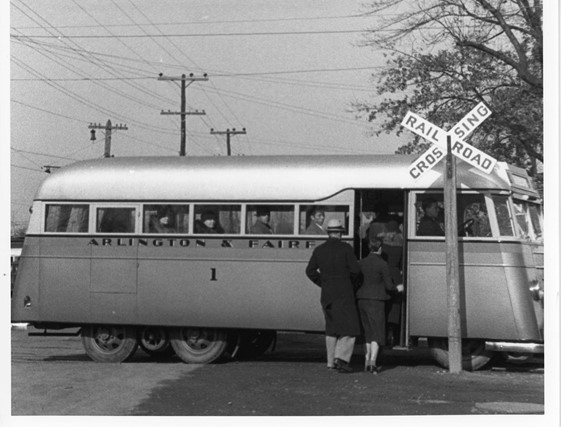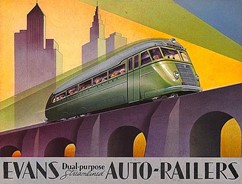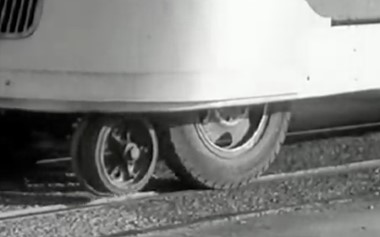1936-1939
Since the first trolley began running in 1896 - from Rosslyn to Fort Myer, just outside of Arlington National Cemetery - public transportation has been an important aspect of Arlington’s identity and development.
Autorailer picking up passengers c. 1938; CLH Collections
Having easy access to public transportation was an integral part of the growth and development of Arlington. The 1930s in Arlington saw a massive rise in population thanks to the government’s New Deal Programs, which brought thousands of government jobs into Arlington. Many workers were forced to live farther and farther away from D.C. as there were few housing options left close to the city. Even though half of American families owned a car by 1930, many still relied on companies like the Washington-Virginia Railway to get them to and from work.
When the Washington-Virginia railway went bankrupt in 1927, local community members and businesses gathered to form their own company, the Arlington & Fairfax Railway Company. By purchasing the former tracks, the new company was able to continue service between Fairfax City and Rosslyn. It also promoted tourism and vacations among D.C. residents, allowing them to travel to local landmarks like Mount Vernon, Great Falls, the National Cemetery, and the Tomb of the Unknown Soldier.
The company, under Vice President G. Hall Roosevelt, nephew of Theodore Roosevelt and youngest brother of Elenanor Roosevelt, operated at a loss for 9 years until deteriorating infrastructure, competition from cars, and the loss of tracks into DC threatened to shut down the line for good.
Detroit Investment
In June of 1936, the Arlington & Fairfax Railway was saved by an investor from Detroit, The Evans Product Company. Evans was looking to break into the streetcar market and chose the D.C. area to promote their new innovation, the Autorailer - a hybrid streetcar and motorbus that was able to travel on both railroad tracks and paved roads, seamlessly transitioning at railroad crossings with the push of a lever.
Life Magazine Ad for Autorailers, August 1936. Photo courtesy of The Old Motor
In exchange for 51% of the company, The Evans Company invested $30,000 to rehabilitate the infrastructure, and supplied six autorailers for immediate use. Between December 1936 and January 1937, Evans spent over $125,000 to replace Arlington's remaining streetcars with the autorailers. To highlight the new technology, they renamed the company “Arlington & Fairfax Auto Railway."
Promotional newsreel made by Chevrolet in 1935 containing the "Evans Auto-Railer," an automobile that runs down railroad tracks in Jackson, Michigan. Prelinger Archives; Public Domain.
"Dual-Purpose and Streamlined"
The Autorailer was designed as a combination trolley streetcar and motor bus, with rubber tires for the road, and flanged wheels that could be set down to ride along the electric railroad tracks. Each vehicle typically had 4 wheels, a Chevrolet or Ford engine, and could carry 20-27 passengers. A rear compartment also allowed for the transport of mail and luggage.
The Arlington & Fairfax Auto Railway Company operated two lines out of Rosslyn starting in December 1936. The Main line went from Rosslyn to Fairfax, via Clarendon, Falls Church, and Vienna. The Arlington Line traveled from Rosslyn to Ft. Myer, via Green Valley and Arlington Cemetery. The Autorailer ran every twenty minutes for 15 cents each way, and commuters could get from Rosslyn to Fort Myer in just under an hour.
Although newspapers at the time claimed that “comparatively little mechanical trouble has been experienced, despite the newness of the vehicle” (Transit Journal, March 1937), contemporary analysis of the autorailer by John E. Merriken in "Old Dominion Trolley Too: A History of the Mount Vernon Line" deemed them, “Relatively primitive vehicles noticeably inferior to both the railcars they replaced and to contemporary motor buses”
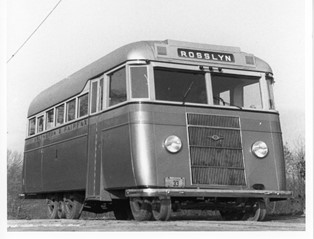
Autorailer, January 1939; CLH collections
Autorailer's flanged wheel and rubber tire, c. 1935; Photo courtesy of The Prelinger Archives
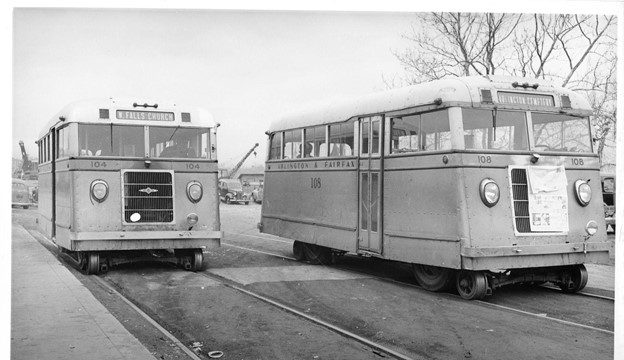
Autorailers going to Arlington Cemetery and West Falls Church c. 1938; photo from CLH Collections
Crossing the Potomac Into DC
Previous trolleys had been able to travel across the Long Bridge to provide service into Washington D.C. This line was abandoned in 1930 when the station was destroyed for the construction of the Federal Triangle.
One of the immediate goals of the Arlington & Fairfax Auto Railway was to regain service into D.C. The company repeatedly petitioned to obtain permission to enter the city over the Key Bridge and resume service down Pennsylvania Avenue, filing at least two applications in 1937.
Although the application was finally granted in November 1938, it isn’t clear whether any autorailers ever crossed over the Potomac River, as two months later the Capital Transit Company successfully defended their right to a monopoly on passenger service in Washington, and the Arlington & Fairfax Auto Railway was barred from using the Key Bridge.
Return to Bankruptcy, and to County Roadways
The loss of service into D.C. was the final nail in the coffin for the Arlington & Fairfax Auto Railway, and by September of 1939, the company was once again bankrupt. With no investors to save them this time, they began to liquidate their stock of autorailers.
While much of the fleet was sold across the country, four remained in Arlington and were sold to the Washington and Old Dominion Railroad. Three were used for general maintenance and repairs and one was converted to do repair work on the overhead electric lines for the tracks until 1944. Most of the railroad tracks were released to the County to be used for roads and highways, including Fairfax Drive, Clarendon Blvd in Arlington, and Electric Avenue in Vienna (Fairfax County).
Regarding Public Transportation and Segregation in Virginia
In 1904, the Virginia General Assembly gave streetcar companies the power to segregate passengers by race. Two years later, the Assembly enacted legislation that required racial segregation on Virginia streetcars. In 1946, forced segregation on interstate buses was declared unconstitutional after Irene Morgan appealed her case to the U.S. Supreme Court. And in 1960, another Supreme Court case, Boynton v. Virginia, banned segregation by race on any type of public transportation. Learn more about this topic at the Virginia Museum of History & Culture.
Do you have a question about this story, or a personal experience to share?
Use this form to send a message to the Center for Local History.
Center For Local History - Blog Post Message Form
Do you have a question about this story, or a personal experience to share? Use this form to send a message to the Center for Local History.
"*" indicates required fields
